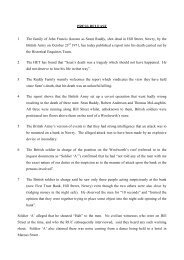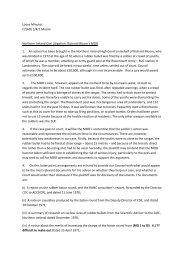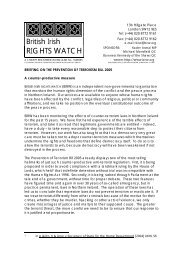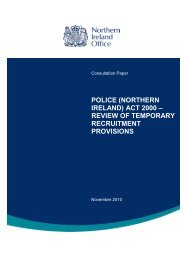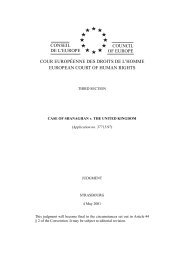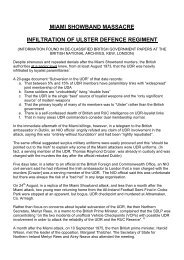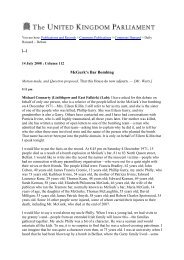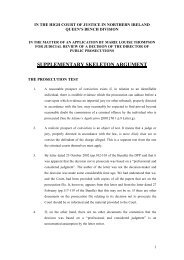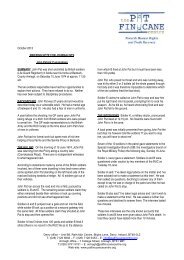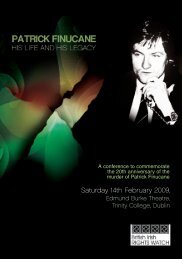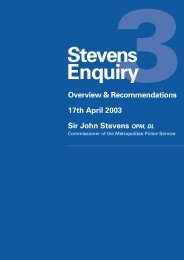HET Review Summary Report into the death of William Francis ...
HET Review Summary Report into the death of William Francis ...
HET Review Summary Report into the death of William Francis ...
Create successful ePaper yourself
Turn your PDF publications into a flip-book with our unique Google optimized e-Paper software.
Statement makers who were acting in an <strong>of</strong>ficial capacity (such as police<br />
<strong>of</strong>ficers or doctors) can be identified.<br />
In this particular case, statements were obtained by <strong>the</strong> RUC, <strong>the</strong> RMP<br />
and by a solicitor who was acting on behalf <strong>of</strong> <strong>the</strong> McGreanery family. A<br />
fur<strong>the</strong>r statement has also been obtained by <strong>the</strong> <strong>HET</strong> as part <strong>of</strong> this<br />
review from a witness who was identified by <strong>the</strong> Pat Finucane Centre. A<br />
synopsis <strong>of</strong> <strong>the</strong> evidence is incorporated within this report but for <strong>the</strong><br />
reasons outlined above, <strong>the</strong> witness cannot be named.<br />
<strong>HET</strong> Comment: The soldier who fired <strong>the</strong> fatal shot and his colleague<br />
made statements to military investigators. They were identified at <strong>the</strong><br />
subsequent inquest only as soldiers ‘A’ and ‘B’. The Coroner’s Rules in<br />
force at that time were that where a person was suspected <strong>of</strong> causing a<br />
<strong>death</strong>, or had been charged or was likely to be charged with an <strong>of</strong>fence<br />
relating to <strong>the</strong> <strong>death</strong>, <strong>the</strong>y were not compelled to give evidence at <strong>the</strong><br />
inquest. If someone in that position volunteered to give evidence <strong>the</strong>n<br />
<strong>the</strong> onus was on <strong>the</strong> Coroner to inform <strong>the</strong> witness that he/she was not<br />
obliged to do so, and that <strong>the</strong>ir evidence may be subject to cross<br />
examination. In those days <strong>the</strong>refore, many potential witnesses exercised<br />
<strong>the</strong>ir right not to give evidence at inquests.<br />
The dilemma faced by Coroners was in balancing <strong>the</strong> need for public<br />
justice against <strong>the</strong> risk <strong>of</strong> denial <strong>of</strong> justice by deterring a witness from<br />
giving evidence. For that reason <strong>the</strong> practice <strong>of</strong> a Coroner granting<br />
anonymity to witnesses became commonplace, especially in respect <strong>of</strong><br />
serving soldiers and police <strong>of</strong>ficers where <strong>the</strong>re were perceived security<br />
threats against <strong>the</strong>m. Once <strong>the</strong> Coroner had agreed to allow a soldier to<br />
give evidence anonymously, <strong>the</strong>ir names were erased from <strong>the</strong>ir<br />
depositions (statements) and were replaced by a letter <strong>of</strong> <strong>the</strong> alphabet,<br />
hence <strong>the</strong> terms soldier ‘A’ and soldier ‘B’ in this case. The Coroner would<br />
<strong>the</strong>n be passed a slip <strong>of</strong> paper with <strong>the</strong> name, rank, regiment and service<br />
number <strong>of</strong> <strong>the</strong> witness. At <strong>the</strong> completion <strong>of</strong> <strong>the</strong> hearing <strong>the</strong> Coroner<br />
would hand <strong>the</strong> note back to <strong>the</strong> military. In <strong>the</strong> interest <strong>of</strong> security, it<br />
was military policy to destroy <strong>the</strong> slip <strong>of</strong> paper after <strong>the</strong> Coroner had<br />
returned it to <strong>the</strong>m.<br />
The Coroners Rules, which in effect gave a suspect <strong>the</strong> absolute right not<br />
to be asked to testify, were called <strong>into</strong> question by a ruling <strong>of</strong> <strong>the</strong><br />
European Court <strong>of</strong> Human Rights (ECHR) in 2001. It was determined that<br />
27/5/2010<br />
10



